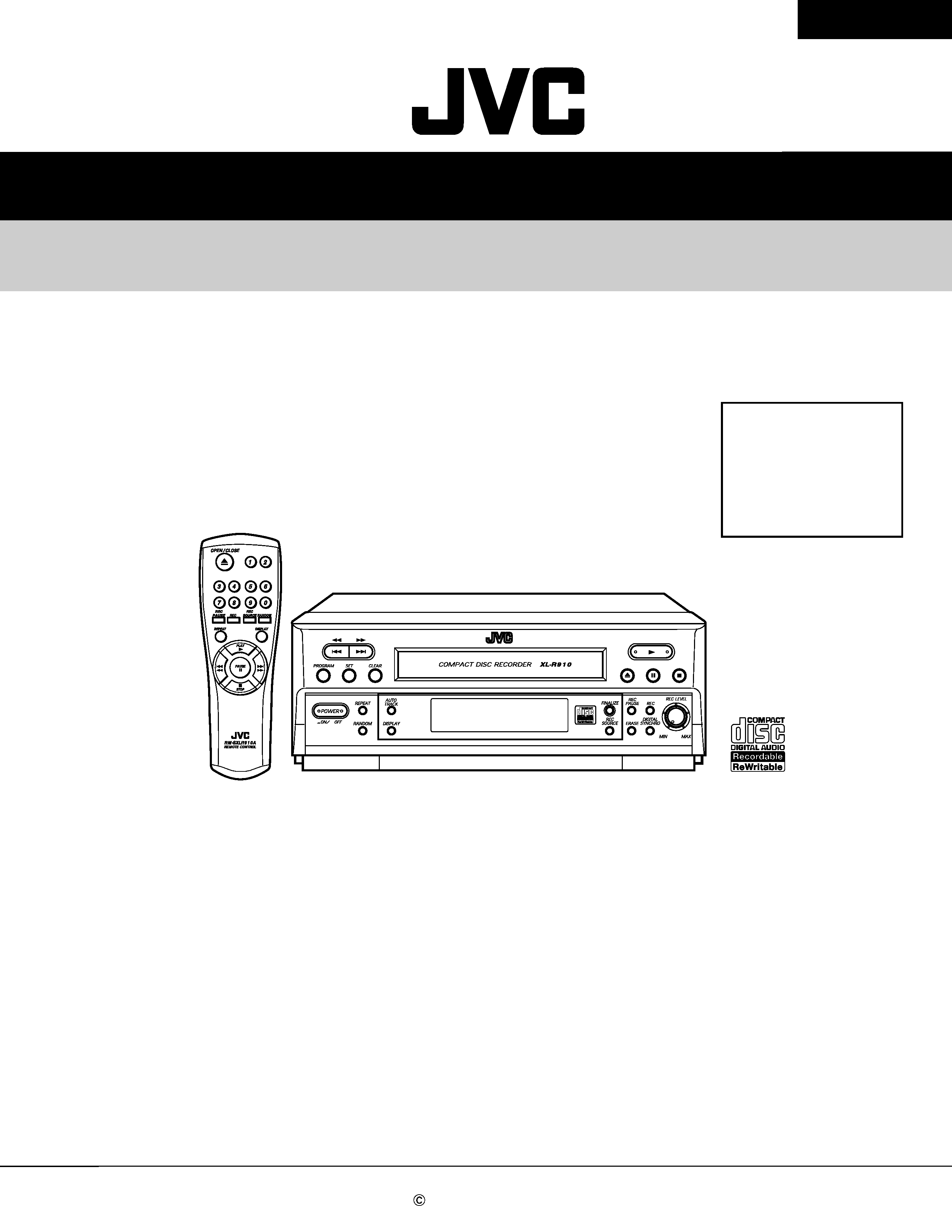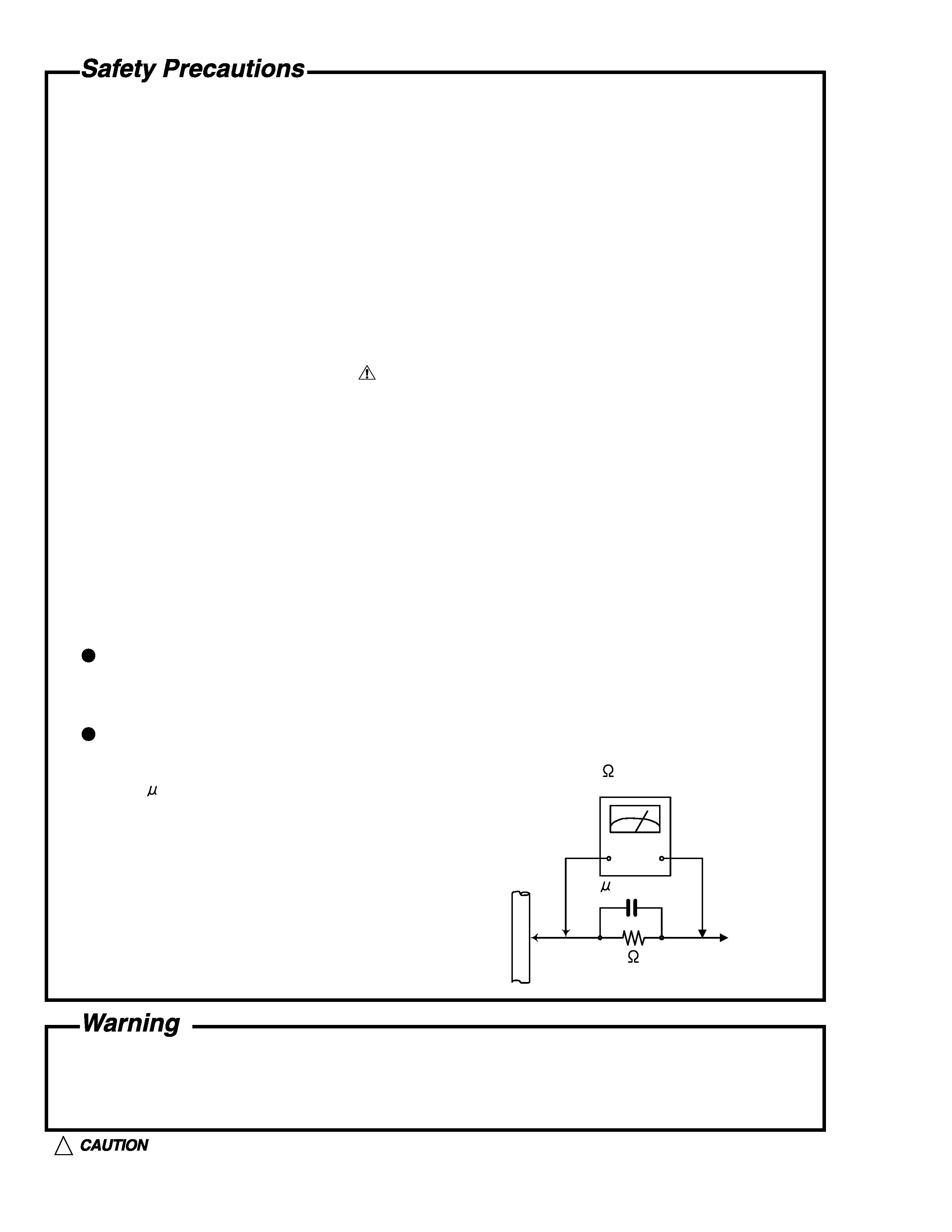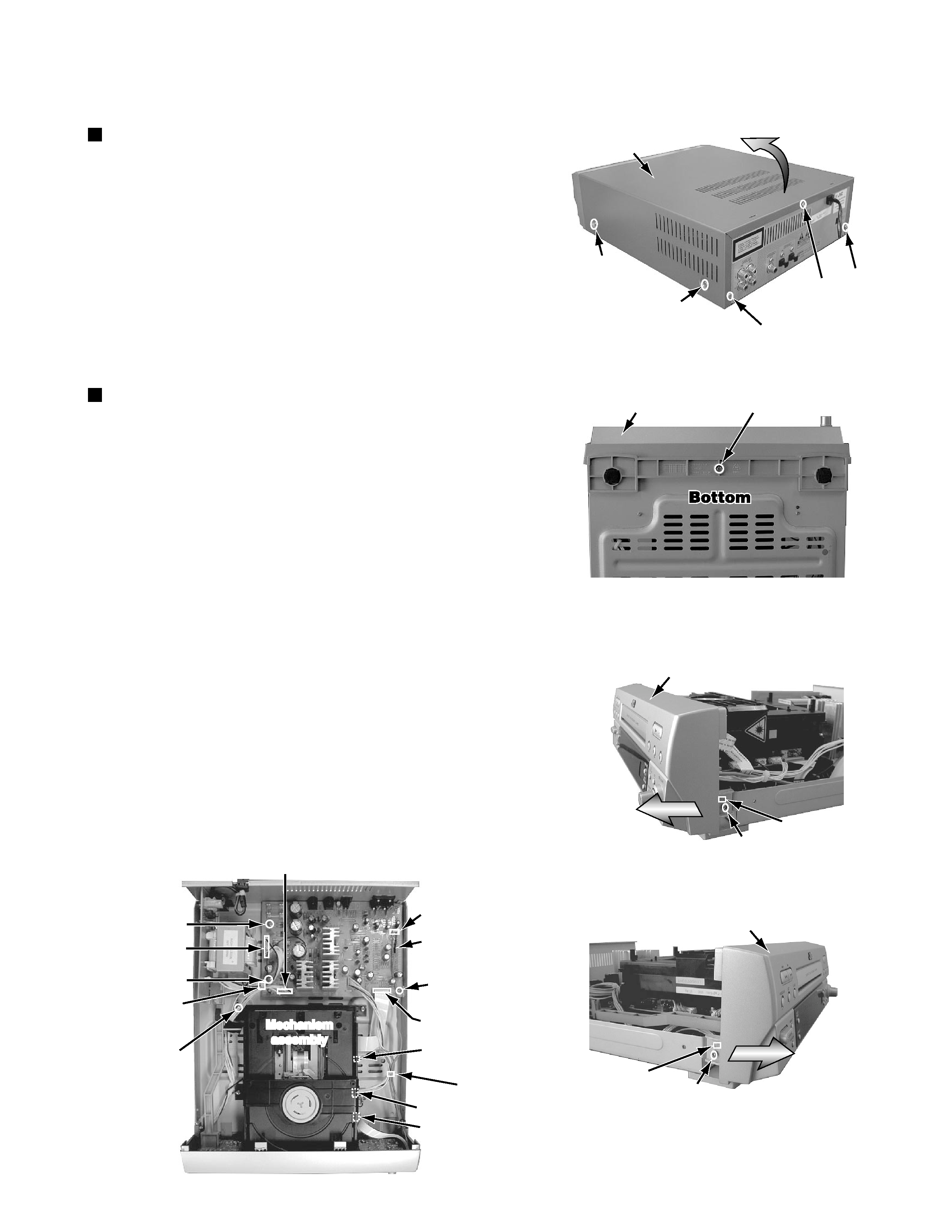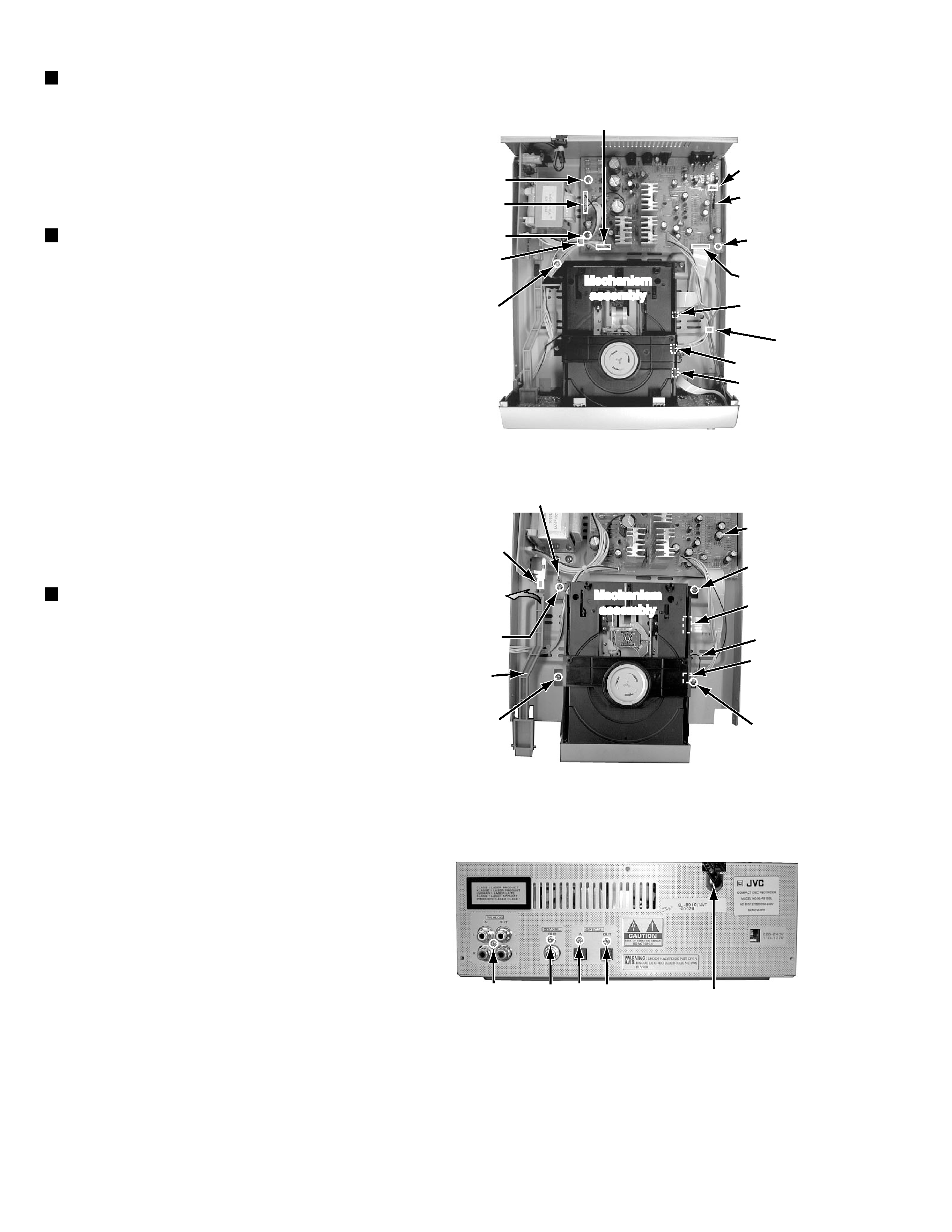
SERVICE MANUAL
COMPACT DISC RECORDER
No.A0009
Apr. 2001
COPYRIGHT
2001 VICTOR COMPANY OF JAPAN, LTD.
XL-R910SL
XL-R910SL
Area Suffix
J ------------------- U.S.A.
C ---------------- Canada
B --------------------- U.K.
E -- Continental Europe
EN --- Northern Europe
This service manual is printed on 100% recycled paper.
Contents
Safety precautions ----------------------- 1-2
Disassembly method -------------------- 1-3
Troubleshooting -------------------------- 1-6
Description of major ICs ---------------- 1-11

XL-R910SL
1-2
1. This design of this product contains special hardware and many circuits and components specially
for safety purposes.
For continued protection, no changes should be made to the original design
unless authorized in writing by the manufacturer.
Replacement parts must be identical to those
used in the original circuits.
Services should be performed by qualified personnel only.
2. Alterations of the design or circuitry of the product should not be made.
Any design alterations of
the product should not be made.
Any design alterations or additions will
void the
warranty
and will further relieve the manufacture of responsibility for personal injury or property damage
resulting therefrom.
3. Many electrical and mechanical parts in the products have special safety-related characteristics.
These characteristics are often not evident from visual inspection nor can the protection afforded
by them necessarily be obtained by using replacement components rated for higher voltage,
wattage, etc.
Replacement parts which have these special safety characteristics are identified in
the Parts List of Service Manual.
Electrical components having such features are identified by
shading on the schematics and by (
) on the Parts List in the Service Manual.
The use of a
substitute replacement which does not have the same safety characteristics as the recommended
replacement parts shown in the Parts List of Service Manual may create shock, fire, or other
hazards.
4. The leads in the products are routed and dressed with ties, clamps, tubings, barriers and the
like to be separated from live parts, high temperature parts, moving parts and/or sharp edges
for the prevention of electric shock and fire hazard.
When service is required, the original lead
routing and dress should be observed, and it should be confirmed that they have been returned
to normal, after reassembling.
5. Leakage current check (Electrical shock hazard testing)
After reassembling the product, always perform an isolation check on the exposed metal parts of
the product (antenna terminals, knobs, metal cabinet, screw heads, headphone jack, control
shafts, etc.) to be sure the product is safe to operate without danger of electrical shock.
Do not use a line isolation transformer during this check.
Plug the AC line cord directly into the AC outlet.
Using a "Leakage Current Tester", measure
the leakage
current from each exposed metal parts of the cabinet , particularly any exposed
metal part having a return path to the chassis, to a known good earth ground. Any leakage
current must not exceed 0.5mA AC (r.m.s.)
Alternate check method
Plug the AC line cord directly into the AC outlet.
Use an AC voltmeter having, 1,000 ohms
per volt or more sensitivity in the following manner. Connect a 1,500
10W resistor paralleled by
a 0.15 F AC-type capacitor between an exposed
metal part and a known good earth ground.
Measure the AC voltage across the resistor with the
AC voltmeter.
Move the
resistor
connection
to each exposed
metal part, particularly any exposed metal part
having a return path to the chassis, and measure
the AC voltage across the resistor. Now, reverse
the plug in the AC outlet and repeat each
measurement. voltage measured Any must
not
exceed 0.75 V AC (r.m.s.). This corresponds to 0.5
1. This equipment has been designed and manufactured to meet international safety standards.
2. It is the legal responsibility of the repairer to ensure that these safety standards are maintained.
3. Repairs must be made in accordance with the relevant safety standards.
4. It is essential that safety critical components are replaced by approved parts.
5. If mains voltage selector is provided, check setting for local voltage.
Good earth ground
Place this
probe on
each exposed
metal part.
AC VOLTMETER
(Having 1000
ohms/volts,
or more sensitivity)
1500
10W
0.15 F AC TYPE
!
Burrs formed during molding may be left over on some parts of the chassis. Therefore,
pay attention to such burrs in the case of preforming repair of this system.

XL-R910SL
1-3
Disassembly method
<Main body>
Removing the metal cover (See Fig.1)
Removing the front panel assembly (See Fig.2~5)
1.Remove the three screws A attaching the metal cover
on the back of the body.
2.Remove the four screws B attaching the metal cover
on both sides of the body.
3.Remove the metal cover from the body by lifting the
rear part of the cover.
ATTENTION : Do not break the front panel tab fitted
to the metal cover.
* Prior to performing the following procedure, remove the
metal cover.
1.Remove the three screws C attaching the front panel
assembly on the bottom of the body and both sides of
the body.
2.Disconnect the card wire from connector CN601 on the
servo control board.
3.Disconnect the 4pin wire from connector CN502 on the
servo control board.
4.Disconnect the 3pin wire and 8pin wire from connector
ACW1 and RCW2 on the main board.
Please remove a tie band if necessary.
Please fix the wire again with a tie band when assembling.
5.Release the two joints a on the lower part of the sides
using a screwdriver, and remove the front panel assembly
toward the front.
Fig. 2
Fig. 3
Fig. 4
C
C
Metal cover
B x 2
A
A
A
Fig. 1
B x 2
C
Front panel assembly
joint a
Joint a
Front panel assembly
Front panel assembly
Fig. 5
ACW1
Main board
Tie band
Tie band
G
NCW1
CN502
CN701
CN601
D
F
F
RCW1
RCW2
Mechanism
assembly

XL-R910SL
1-4
Removing the power button arm (See Fig.6)
* Prior to performing the following procedure,
remove the metal cover and front panel assembly.
The power button arm is lifted up while holding the
power switch(orange color part) and removes.
Removing the mechanism assembly
(See Fig.6)
* Prior to performing the following procedure,
remove the metal cover and front panel
assembly.
1.Disconnect the card wire from connector CN501
on the servo control board.
2.Disconnect the 6pin wire from connector CN701
on the servo control board.
3.Remove the four screws D attaching the
mechanism assembly.
*Please fix two earth wires together when you
install the mechanism assembly.
Removing the main board (See Fig.5,7)
* Prior to performing the following procedure,
remove the metal cover.
1.Remove the four screws E attaching the each
terminal on the rear panel.
2.Disconnect the 9pin,8pin and 3pin wire from
connector RCW1,RCW2 and ACW1 on the main
board.
3.Disconnect the card wire from connector NCW1
on the main board.
4.Disconnect the 6pin wire from connector CN701
on the servo control board.
5.Remove the screw D attaching the earth wire.
6.Remove the two screws F and one screw G
attaching the main board.
Please remove a tie band if necessary.
Please fix the wire again with a tie band
when assembling.
Fig. 6
Main board
D
D
D
D
Mechanism
assembly
Power
button
arm
Orange
color part
Earth wire
CN501
CN701
Earth wire
Fig. 7
E
E
E
E
Cord bushing
Fig. 5
ACW1
Main board
Tie band
Tie band
G
NCW1
CN502
CN701
CN601
D
F
F
RCW1
RCW2
Mechanism
assembly

XL-R910SL
1-5
Removing the power transformer (See Fig.6~8)
* Prior to performing the following procedure,
remove the metal cover.
1.Power button arm is removed from power switch
2.Disconnect 9pin wire from connector RCW1 on
the main board.
3.The code bushing is pulled out for above.
4.Remove the four screws H attaching the power
transformer.
Please remove a tie band if necessary.
Please fix the wire again with a tie band when
assembling.
Fig. 6
Mechanism
assembly
Power
button
arm
Orange
color part
Tie band
Fig. 8
Main board
Power transformer board
Power transformer
H
H
RCW1
Tie band
Fig. 7
Cord bushing
